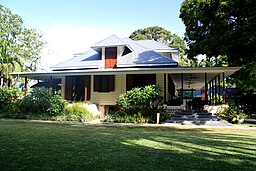| La Plaine St. André | |
|---|---|
 The Plantation House at La Plaine St. André in Victoria, Seychelles (2012) The Plantation House at La Plaine St. André in Victoria, Seychelles (2012) | |
 | |
| Type | National Heritage Site |
| Location | Au Cap, Mahé, Seychelles |
| Coordinates | 4°43′10″S 55°31′23″E / 4.719424°S 55.523092°E / -4.719424; 55.523092 |
| Area | 15 acres |
| Opened | 1792 (1792) |
| Operated by | Trois Frères Distillery |
La Plaine St. André is a colonial-era sugarcane plantation located in the southeast of Mahé, Seychelles.
History
The national heritage estate, situated in Au Cap and formerly recognized as Eco-Musée, traces its origins to 1792. Originally owned by Jean-Francois Marie Jorre de St. Jorre, who hailed from Saint Andre de La Reunion, the estate was named La Plaine St. Andre. It stretched from Au Cap to Anse Royale. During Seychelles' time as a French colony, it was a major plantation, supplying much of the island's southern area with agricultural produce.

In 1996, the national anthem of Seychelles, Koste Seselwa was composed by David André and Georges Payet at an old house at La Plaine St. Andre.
In 2007, Trois Frères Distillery, the creators of Takamaka Rum, entered a long-term lease agreement with the Seychelles Heritage Foundation (SHF) to oversee the management of the estate.
Historical discrepancies
There isn't enough evidence to confirm that "La Plaine Saint André" was built around 1792. According to local historian Julien Durup, the wooden structures wouldn't last that long in Seychelles' humid climate with termites. Jean-François Marie Jorre de Saint Jorre, born in La Réunion in 1758, arrived in Seychelles in April 1790, not as one of the first settlers as previously believed. He was granted land at Pointe La Rue and Anse Aux Courbes, while his wife also received land in 1792. If Jean-François named his property "La Plaine Saint André" out of nostalgia for his birthplace, it doesn't mean he built his mansion at the same time.

Also, the original masonry basement of the 'Plantation House' suggests it was constructed between 1844-60 during the ownership of André Despilly Jorre de Saint Jorre. Despilly, a notable Master Mason and notary, was associated with the 'La Réunion Sincère' and later the 'Lodge Union Sincère,' founded by Pascal de Giovanni in 1869 at Royal Street, Paris. The 'La Réunion Sincère,' acquired by Ange Joseph Marie Cordouan in 1831, ceased operations in 1851. The 'Plantation House' served as a meeting venue for the Masonic community on various occasions.
Architecture
The buildings on the plantation represent colonial-era architecture. The plantation house, with its distinctive Creole design characterized by wide verandas and steep-pitched roofs, is a focal point of the estate. The estate also features an herbs & medicinal garden, and a restaurant serving Creole cuisine.
Distillery
| Type | Rum |
|---|---|
| Manufacturer | Trois Frères Distillery |
| Country of origin | Seychelles |
| Introduced | 2002 |
| Alcohol by volume | 25%-69% |
| Proof (US) | 94% |
| Related products | List of rum producers |
| Website | www |
Takamaka rum is a brand of rum that is distilled, aged and blended at the Trois Frères Distillery on the site of La Plaine St André. The distillery has been operating since 2002, and was founded by the d’Offay brothers, Richard and Bernard d’Offay. It is the first and only commercial rum producer and exporter in Seychelles.
History

Rum was first introduced to the Seychelles in the mid 16th century by the British Navy. Sugar cane cultivation on the islands began in the late 1800s and early 1900s, primarily to supplement the supply of sugar from infrequent visits from ships. As the delivery of sugar to the islands became more frequent, the use of sugar cane began to evolve - initially to making fermented cane juice known as 'Baka'.
Residents also have a history of making their own rhum arrangé, a mixture of local rum and a blend of herbs and spices (usually a family recipe). This is traditionally served as a digestif (post-meal drink).
The Trois Frères Distillery was founded in 2002 and is located on an old tropical spice plantation site (La Plaine St André). The d'Offay family was granted a lease for the property, which is a national heritage site, and restored it for two and half years to set up the distillery.
References
- ^ "La Plaine St. Andre | Seychelles Heritage Foundation". www.seyheritage.sc. Retrieved 2024-04-04.
- "La Plaine St Andre raises public awareness on environmental conservation -Archive -Seychelles Nation". www.nation.sc. Retrieved 2024-04-04.
- Ganapathy, Priya (2015-02-07). "Secret sands". The Hindu. ISSN 0971-751X. Retrieved 2024-10-29.
- "'It still feels like a new song whenever we hear the national anthem' -Archive -Seychelles Nation". www.nation.sc. Retrieved 2024-04-04.
- ^ ""La Plaine Saint André" - The Servile Population Should Never be forgotten". www.seychellesweekly.com. Retrieved 2024-04-04.
- "La Plaine St André honoured top performing restaurant -Archive -Seychelles Nation". www.nation.sc. Retrieved 2024-04-04.
- "A guide to island-hopping in the Seychelles". Travel. 2023-09-09. Retrieved 2024-10-29.
- ^ Kabukuru, Wanjohi. "How two Seychellois brothers tweaked grandpa's recipe to create a rum that has become a global brand". www.seychellesnewsagency.com. Retrieved 2024-10-05.
- Bonnelame, Beytymie. "Seychelles' Trois Freres Distillery sets up Islands Bar Sustainability project". www.seychellesnewsagency.com. Retrieved 2024-10-05.
- ^ Bonnelame, Sandra. "Captivating Charms of Seychellesʹ Takamaka Distillery". Seychelles Tourism. Retrieved 2024-10-05.